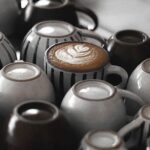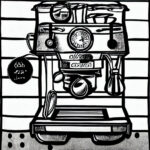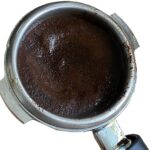When it comes to making espresso, there are a few things that don’t really matter. The puck’s sogginess, tamp pressure, and the ridge on the basket as these are all factors that don’t have a significant impact on the quality of the shot.
The volume of the dose compared to the size of the basket, the size of the grind, and the freshness of the coffee are much more important. The ridgeless version of a precision basket may be easier to insert and remove from the portafilter, but it doesn’t make a difference in the extraction. Ultimately, what matters is what’s in the cup.
What Is Important When Working With Espresso Pucks
To make the best espresso puck, there are several important factors to consider, including:
- Quality of the coffee beans: Starting with high-quality coffee beans is essential for producing a great-tasting espresso.
- Grind size: The grind size should be adjusted to produce the right extraction time and flavor profile. Generally, a finer grind will result in a slower extraction and a stronger, more flavorful shot. You should invest in a good grinder, specifically a burr grinder (Flat or conical).
- Distribution: The grounds should be distributed evenly throughout the basket to prevent channeling and ensure an even extraction.
- Tamping pressure: The coffee grounds should be evenly and firmly tamped into the portafilter to ensure consistent extraction and a well-formed puck.
- Water temperature and pressure: The water temperature should be between 195-205°F and the pressure should be around 9 bars to ensure proper extraction and a balanced shot.
By paying attention to these important factors, you can make the best espresso puck possible and enjoy a delicious, high-quality espresso shot.
What isn’t as important when working with Espresso Pucks
When working with your espresso puck, the following factors may not be as important:
- Price of the espresso machine: While expensive espresso machines can offer advanced features, it is still possible to make high-quality espresso with a more affordable machine.
- Size of the espresso machine: The size of the espresso machine does not necessarily determine the quality of the espresso produced. A smaller machine can still produce excellent espresso if used properly.
- Type of cup used: While the cup can affect the flavor of the espresso, it is not as important as the quality of the puck and the espresso extraction process.
- Size of the Portafiter. We have a great article that goes into a lot more detail between 58mm and 54mm portafilters.
- Fancy latte art: While latte art can be impressive, it does not necessarily reflect the quality of the espresso shot itself. The focus should be on the flavor and quality of the espresso.
Soggy Pucks
Have you ever wondered why the puck of espresso is so soggy? Many people take this as a bad sign, believing that it is a sign of some mistake that needs to be corrected. However, this is not necessarily true.

We have had both great and terrible shots from both soggy and dry pucks. The extra water could be due to the dose size, grind size, or even the roast of the coffee. Ultimately, what matters is what is in the cup – the water was left in the machine for a reason.
There are 3 main reasons for a soggy puck.
Small Grind Size. Setting your grinder to a bigger grind size should allow more water to pass through the puck.
Tamp Pressure – If you over tamp your grounds, it may result in a puck where water has a harder time passing through. The recommended pressure that most Baristas try to achieve is somewhere between 25 – 35 pounds. Going over that amount can create a more densely packed puck, preventing water flow.
Not Enough Grounds – It could be that you simply don’t have enough grounds in your portafilter. Adding additional grounds will help soak up some of the excess water.
NOTE: Many Home Baristas like to use a Puck Screen to help even the distribution of the water on the puck. Puck screens may also help prevent a soggy puck situation.
Tamp Pressure
Tamp pressure is often a topic of debate among baristas, but our research shows that it doesn’t make much of a difference. Some baristas say that tamp pressure does matter when making espresso. The amount of pressure used to tamp the ground coffee into the portafilter can affect the extraction rate and the flavor of the espresso. Too little pressure can lead to an under-extracted espresso, while too much pressure can lead to an over-extracted espresso.
The ideal tamp pressure for espresso is usually between 25 to 35 pounds.
Ridge or Ridgeless Baskets
The ridge on your basket is the least important factor to consider. This ridge is simply there to help the basket get a better grip from the spring in your portafilter, making it fit more snugly.

When looking at precision baskets like the VST, people often wonder if there is a difference between the ridged and ridgeless versions and if it affects extraction. The ridgeless basket simply lacks the ridge. Some people prefer this version because it is easier to insert and remove from the portafilter. Others believe it might produce more even flow. However, we have not been able to detect a noticeable difference in results between ridged and ridgeless baskets, so either way you should get more consistent shots than with a standard basket.
Bottom Line
If your espresso isn’t pulling to recipe, look at the GRIND, DOSE, and COFFEE FRESHNESS before trying to press the puck.







